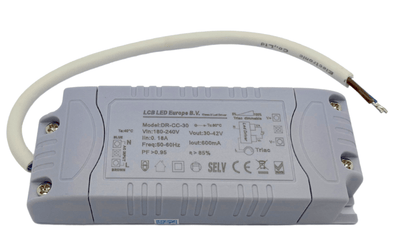
Leading/Trailing Edge
Dimmers offer the ability to adjust light intensity, contributing to the ambiance and functionality of a room. In the world of dimmers, we mainly distinguish between two techniques: leading edge and trailing edge. These methods determine the way electricity is regulated to the lamp in order to enable dimming. Knowing the difference helps you choose the right dimmer for your lighting.
How Leading Edge Dimmers Work
Leading edge dimmers, often referred to as 'Leading Edge' or RL dimmers, work by cutting off the beginning of the AC sine wave. This results in a shorter period during which the full voltage is sent to the lamp, thereby reducing the average voltage and causing the lamp to burn less brightly. This technique is traditionally suitable for incandescent bulbs, 230V halogen bulbs, and conventional (wound) transformers for low-voltage halogen lighting.
With LED lighting, leading edge dimmers can sometimes cause problems, such as flickering, buzzing, or a limited dimming range. This is because the electronics in many LED bulbs cannot handle the sudden start of the voltage each cycle very well.
How Trailing Edge Dimmers Work
Trailing edge dimmers, also known as 'Trailing Edge' or RC dimmers, cut off the end of the sine wave. This method provides a more even voltage build-up and is generally better suited to modern light sources. They are compatible with dimmable LED bulbs and electronic transformers for low-voltage halogen lighting.
The advantage of trailing edge dimming is that it offers a smoother dimming range, often down to a very low level, and is less likely to cause the aforementioned side effects such as flickering or buzzing with LED lights. Many universal LED dimmers use the trailing edge technique, or can automatically switch between both methods.
Compatibility of Dimmers and Light Sources
The right combination of dimmer and bulb is important for stable dimming performance. An incorrect combination can lead to unwanted effects such as flickering bulbs, buzzing sounds, or even a shortened lifespan of the bulb.
Always check the specifications of both the dimmer and the bulb. The packaging of the dimmer often indicates which lamps it is suitable for (for example, 'R' for incandescent bulbs, 'C' for trailing edge, 'L' for leading edge, or 'RLC' for universal). For dimmable LED bulbs, a trailing edge ('RC') dimmer or a universal dimmer ('RLC') is generally the best choice.
Dimmability Overview by Dimmer Type
| Dimmer Type | Suitable For | Remarks |
|---|---|---|
| Leading Edge (RL) | Incandescent bulbs, 230V Halogen, Conventional transformers | Can cause issues with LEDs, such as flickering or buzzing. |
| Trailing Edge (RC) | Dimmable LED bulbs, Electronic transformers | Offers a smoother dimming range, often quieter with LEDs. |
| Universal (RLC) | Most dimmable bulbs (LED, Halogen, Incandescent) | Dimmers that automatically detect and apply the correct method. |
Important Considerations When Choosing a Dimmer
In addition to the dimming principle, there are other factors that influence the performance of a dimmer:
- Minimum and maximum load (Watt): Every dimmer has a minimum and maximum connected capacity. The total wattage of all connected bulbs must fall within this range. If the load is too low, lamps may flicker. Allow for a 10-15% margin under the maximum load to maintain stability and prevent overload.
- Adjustability (min/max level): Many modern dimmers have an adjusting screw or digital setting to correct the minimum and/or maximum dimming level. This is useful for preventing flickering at low light levels or optimizing the dimming range.
- Silent dimming: Some dimmers can produce a buzzing noise, especially with LED lighting. Choose dimmers specifically marketed as 'silent'.
- Soft-start function: This ensures that the lamp gradually turns on, which can extend its lifespan and creates a more pleasant effect.
- Brand compatibility of cover material: Check whether the dimmer is compatible with the cover material (switch plates, dials) of the brands of switching material you use (e.g. Busch-Jaeger, Gira, Jung). Many dimmers are universally fitting, but always check this.
Frequently Asked Questions About Dimmers
Can I connect multiple LED bulbs to one dimmer?
Yes, multiple LED bulbs can be connected to one dimmer, as long as the total wattage of the bulbs falls within the dimmer’s minimum and maximum load range. Also take into account the inrush current of the bulbs.
My LED lighting flickers or buzzes, what am I doing wrong?
Flickering or buzzing is often caused by incompatibility between the dimmer and the bulb, too low a minimum load, or mains interference. Check whether the dimmer uses the correct technique (trailing edge for LED) and that the total wattage of the bulbs is above the dimmer's minimum load. An adjustment screw on the dimmer can help set the minimum dim level to reduce flickering.
How do I set the minimum and maximum dim levels on a dimmer?
Many dimmers have small adjustment screws or knobs, often hidden behind the cover plate. Turn the dimmer to the lowest setting. Then use a small screwdriver to slowly turn the adjustment screw until the bulbs light up stably without flickering. Repeat this if necessary for the maximum setting.
How do I know if my bulb is dimmable?
The dimmability of a bulb is usually clearly indicated on the packaging. Look for a dimmer symbol or the text ‘dimbaar’ or ‘dimmable’. Without this indication, the bulb is not suitable for dimming.
Dimmer installation
Connecting a dimmer should be done carefully. Always turn off the power at the distribution board before you begin installation. Dimmers usually have two or three connection points: a phase wire (brown), one or two switch wires (black) to the bulbs, and sometimes a neutral wire (blue). Always consult the specific instructions for the dimmer for the correct wiring. If in doubt, it is advisable to consult a qualified electrician.

